
Brass instruments are at the heart of so many of the most popular styles of music. From jazz to soul, or gospel to classical, you’ll almost always find some variety pressed to the lips of a strong-lunged musician. Whether you are gearing up to step in line with a marching band, or joining a quartet on stage at a smoky jazz club—having the right brass instrument makes all the difference.
 What is a brass instrument?
What is a brass instrument?
Did you know that technically not all brass instruments have to be brass? They are actually defined by the way they produce sound—not their material. Any instrument where a tubular resonator produces sympathetic vibrations in conjunction with the vibration of the player’s lips is generally considered to be part of the “brass” family.
Some brass instruments can be made from materials like wood, such as the didgeridoo. Other instruments can be made of brass but belong to another family altogether, such as the saxophone, which is actually a woodwind instrument!
Here are a few of the most popular brass instruments:
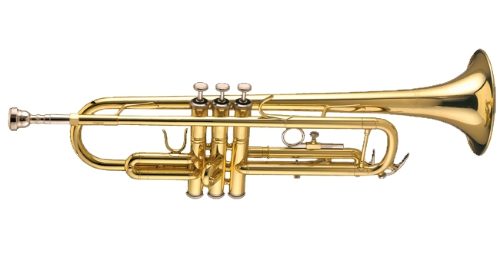 The Trumpet
The Trumpet
The trumpet is one of the earliest types of brass instruments. With its ability to produce loud tones, it was often used to sound alarms or initiate gatherings, or even as a signal in war. Today it is a staple in many ensembles, particularly jazz and classical.
Trumpets typically feature 3 valves (although 2 and 4 valve trumpets also exist). These are pressed by the player’s fingers in conjunction with the buzzing of the lips into the mouthpiece. The various combinations here allow the trumpeter to produce different pitches.
The Trombone
The trombone is very similar to the trumpet in its makeup. In fact, the name trombone comes from the Italian for “large trumpet”.
Instead of using valves, however, the trombone utilizes a slide to change the pitch of the instrument. A U-shaped pipe is moved between 7 basic positions along the length of the trombone. The length of the pipe in any given position will produce a corresponding pitch.
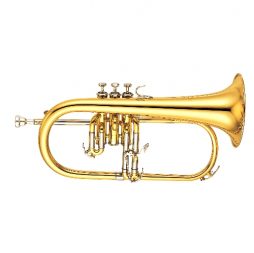 The Flugelhorn
The Flugelhorn
The flugelhorn puts a slightly different spin on the traditional brass horn. In this case the primary difference is a wider conical interior chamber, or “bore”.
The flugelhorn is used frequently in jazz ensembles, but may also appear in concert bands and orchestral arrangements. Its tone is described as a bit more mellow than that of a trumpet.
The Cornet
The cornet is yet another near-doppelganger that closely resembles the trumpet. The key difference here is the expanding, conical shape of the cornet’s bore. The trumpet has a more cylindrical shape in comparison.
Similar to the flugelhorn, the cornet takes on more of a dark, mellow tone compared to the trumpet. It can also be favoured more among beginner players. It balances more beneficially to the player, making it easier to hold.
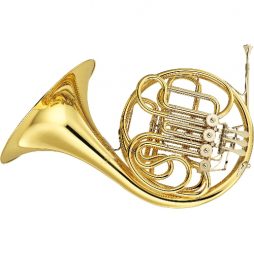 The French Horn
The French Horn
True to its name, the French horn originated in France around the 17th century. Unlike the straighter lines of instruments like the trumpet or trombone, its tubing rolls up into more of a circular shape.
The French horn can be more difficult to learn than many of its contemporaries. In addition to traditional hand-controlled valves, changing pitch requires both control over the speed of air travelling through the instrument, as well as the diameter of the player’s lips.
The Tuba
The tuba produces the lowest pitch of any member of the brass family. While similarly controlled by hand-operated valves, the tuba also requires much greater lung force to produce a sound. Mastering the tuba, however, can be very rewarding as its deep, rich baritones often provide the backbone of any orchestra.
The sheer size of the tuba may also be prohibitive to some potential tubists, particularly if being played in a marching band.
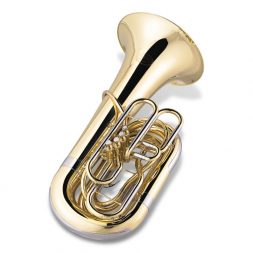 The Euphonium
The Euphonium
The euphonium could probably be considered a friendly alternative to the girth of the tuba. It provides the next-deepest baritones of any brass instrument next to the tuba, but within a more compact frame.
Many marching bands, particularly school bands featuring younger musicians, will utilize the euphonium in place of the tuba as a more practical alternative.
Choosing the right brass instrument
If you are thinking about playing a brass instrument but haven’t decided which one is the right choice, there are many factors to consider. Here are some things to keep in mind when choosing a brass instrument for a new musician.
Player age and size
As is made apparent in the description of the instruments above, members of the brass family come in many shapes and sizes. Some instruments may be suited better than others to aspiring musicians based on the ease with which they can be properly held.
The cornet, for example, is often praised as a good beginner instrument for smaller children. It is one of the smallest, and therefore most lightweight, horns. Its center of gravity is closer to the player, making it easier to hold. Conversely, the tuba can be prohibitively large and heavy for some players, while the euphonium is a more practical choice for a baritone instrument.
Younger musicians may also benefit from starting out with an instrument that requires fewer skills to master. They may wish to avoid choosing a more complex instrument (like the French horn) to begin with. The French horn requires more effort in controlling the speed of air and shape of the mouth in addition to the regular buzzing of the lips and valve work.
 Travel and storage
Travel and storage
The size of a brass instrument doesn’t just matter during the time when you are playing it. It’s also important to be aware of its mobility, as well as the space it takes up.
Remember that you will need to store an instrument when you are not using it. Some brass instruments store easily on a shelf, or tucked under a bed. Others, however, will take up significantly more space. Be sure to consider this when deciding where to safely store your instrument.
Instruments frequently need to travel between home, school, lessons, and more. If you usually drive between these locations and have spacious cargo space, you will probably fare better with a large instrument like the tuba than most.
Smaller and/or younger children who normally walk between places will struggle when having to manage a large instrument on a regular basis. They should likely consider a smaller and more portable horn such as a trumpet or cornet.
Choosing a proper case
Regardless of whether you are driving or walking, a proper case for your brass instrument is a must. An instrument is an investment, and you’ll want to properly protect it when not in use.
When purchasing an instrument, it may or may not come with a case. If not, you’ll want to make sure any case that you purchase fits the instrument correctly. Using the wrong size or type of case can lead to unintentional damage.
Hard shell instrument cases tend to be heavier, but ultimately offer the best protection against damage. Soft shell cases, on the other hand, are lighter and often easier to carry, but offer slightly less protection against outside physical forces. Consider this when deciding which type of case best suits your needs.
 Volume and noise considerations
Volume and noise considerations
One of the key characteristics of brass instruments is their capacity for volume. By their very nature these instruments work thanks to naturally loud resonating vibrations. They are regularly the loudest instruments in an orchestra or ensemble, and their sound can travel over long distances.
Consider whether or not you have an appropriate space for practicing a brass instrument. It may be difficult to practice in an area of highly condensed population, such as an apartment building. Furthermore, a small closed-in space may make the volume troublesome to the players themselves.
If noise is a concern, one of the most practical and necessary accessories for brass instruments is the mute. Mutes are devices that fit to a musical instrument and can affect the tone, reduce the volume, or, frequently, both. The “practice mute” in particular is designed specifically to reduce the volume of a horn, making it an indispensable tool for aspiring students.
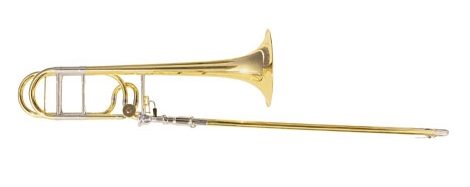 Other accessories and add-ons
Other accessories and add-ons
Once the decision has been made and you are committed to your instrument, there are a number of other accessories that can improve your learning and playing experience. Here are a few different options to consider.
Mouthpieces
Mouthpieces are an interchangeable part of most brass instruments, and can be replaced to suit the player’s need, style, or desire for quality.
The size and shape of a mouthpiece will have a significant effect on the sound it produces. For example, a larger inner rim diameter will produce a richer tone, while a more narrow one will improve an instrument’s capability of playing higher ranges. Mouthpiece design will also affect its ease of play. A wider rim will reduce pressure and increase stamina, but at the cost of flexibility.
Material has a large bearing on the quality of a mouthpiece as well. While traditionally being solid brass, mouthpieces usually feature a silver or gold coating. Plastic mouthpieces are also not uncommon.
Silver-plating is common as it is cost-effective and good in terms of tone quality. Gold-plating can produce fuller and richer tones, but it requires more maintenance and can be cost-prohibitive.
Music stand
A proper music stand is another must for any musician. You simply can’t play your instrument skillfully if your sheet music is not properly visible. Music stands are critical to ensuring you can achieve the correct viewing angle when holding your instrument.
 Sheet music
Sheet music
One of the most thrilling things about learning an instrument is choosing the music that you wish to play. Best Buy offers a huge assortment of sheet music in a variety of styles and skill levels. Having a variety of music on hand can make practicing your instrument fresh and exciting, as well as helping to avoid the risk of fatigue or disinterest.
Other odds and ends
Finally, rounding out the list with a few other items to consider, a care kit for your specific instrument can help with keeping your investment clean and in good working order. Lubricants, cleaning cloths, and flexible brushes are just a few items that commonly make up these kits.
A strap may also be beneficial, depending on your instrument. They can ease the burden of holding your instrument’s weight over an extended time, and reduce the risk of accidental drops.
Lastly, many valved brass instruments use string to regulate their movement. Often, horn players don’t tend to give this component much thought, but it does wear down over time. Having the foresight to keep extra string on hand for an unexpected break can be a huge win.
Take the next step

Finding the perfect instrument to suit your taste can mean all the difference when embarking on your first musical adventure. Taking the time to consider musical taste and performance style in conjunction with skill and life circumstances will ultimately lead to a much happier musician down the road.
Whether you are a brand new player or a seasoned professional, Best Buy has a large selection of brass instruments and accessories to suit your needs.



